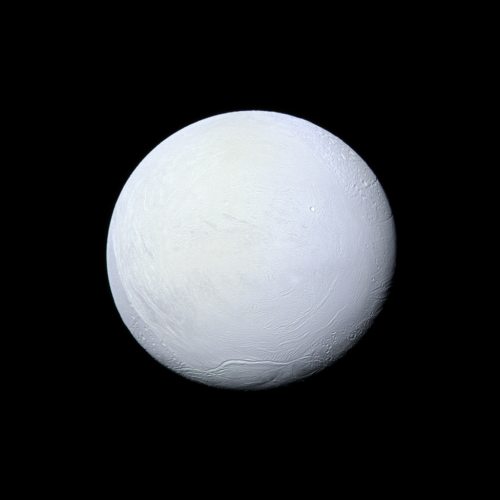Saturn’s Moon Enceladus, Covered In Snow And Ice, Resembles A Perfectly Packed Snowball In This Image

Saturn’s moon Enceladus, covered in snow and ice, resembles a perfectly packed snowball in this image from NASA’s Cassini mission.
Image credit: NASA/JPL-Caltech/Space Science Institute
More Posts from Riekod and Others
the fact that stars even exist and we can look at them every night for free just makes me go !!!!!!!!!!!!!!

The Andromeda Galaxy Floats Above the Dawn Clouds - May 6, 2017
Joseph Brimacombe

Pluto Found - January 23, 1930









What Will Happen When Betelgeuse Explodes?
“Every star will someday run out of fuel in its core, bringing an end to its run as natural source of nuclear fusion in the Universe. While stars like our Sun will fuse hydrogen into helium and then – swelling into a red giant – helium into carbon, there are other, more massive stars which can achieve hot enough temperatures to further fuse carbon into even heavier elements. Under those intense conditions, the star will swell into a red supergiant, destined for an eventual supernova after around 100,000 years or so. And the brightest red supergiant in our entire night sky? That’s Betelgeuse, which could go supernova at any time.”
One of the most sobering cosmic truths is that every star in the Universe will someday run out of fuel and die. Once its core fuel is exhausted, all it can do is contract under its own gravitational pull, fusing heavier and heavier elements until it can go no further. Only the most massive stars, capable of continuing to fuse carbon (and even heavier elements) will ever create the Universe’s ultimate cataclysmic event: a Type II, or core collapse, supernova. Stars that are fusing carbon (and up) appear to us today as red supergiants, and the brightest red supergiant as seen from Earth is Betelgeuse. Sometime in the next 100,000 years or so, Betelgeuse will go supernova. When it does, it will emit incredible amounts of radiation, become intrinsically brighter than a billion suns and and be easily visible from Earth during the day. But that’s not all.
What’s the full story on what will happen when Betelgeuse goes supernova? Come get the science today!

SNR 0509-67.5: a remnant from a supernova in the Large Magellanic Cloud
Credit: NASA/ESA/Hubble Team/Kevin M. Gill

The real reason mankind went to the Moon is this lady. Amazing. https://www.instagram.com/p/BsfnmjshAA3/?utm_source=ig_tumblr_share&igshid=p1ybbxv208af



Liquid oxygen is magnetic
Liquid oxygen sticks between the poles of a strong magnet until it boils away into its gas state. This is because it has unpaired electrons, which make each oxygen molecule a tiny magnet with a dipole. Normally, when oxygen is in a flask or in the air, these microscopic magnets point in all directions, cancelling out and meaning that there’s no net magnetic field. When it pours over the permanent magnet, the magnetic molecules all slightly align, creating an induced magnetic field, which reacts with the permanent magnet, making the oxygen stick to the poles. This is called paramagnetism. Click here to watch the video.



Cloud Chambers: Visualizing Radiation
The cloud chamber, also known as the Wilson chamber, is a particle detector used for detecting ionizing radiation.
In its most basic form, a cloud chamber is a sealed environment containing a supersaturated vapor of water or alcohol. When a charged particle (for example, an alpha or beta particle) interacts with the mixture, the fluid is ionized. The resulting ions act as condensation nuclei, around which a mist will form (because the mixture is on the point of condensation).
The high energies of alpha and beta particles mean that a trail is left, due to many ions being produced along the path of the charged particle. These tracks have distinctive shapes, for example, an alpha particle’s track is broad and shows more evidence of deflection by collisions, while an electron’s is thinner and straight. -(x)
More science and gifs on my blog: rudescience Gif made from: This video by The Royal Institution References: (x), (x).
-
 cultureshocked liked this · 3 months ago
cultureshocked liked this · 3 months ago -
 warcotuj8746 liked this · 9 months ago
warcotuj8746 liked this · 9 months ago -
 trailmix-7 reblogged this · 11 months ago
trailmix-7 reblogged this · 11 months ago -
 messagesfromthestars8 liked this · 11 months ago
messagesfromthestars8 liked this · 11 months ago -
 nikidanger liked this · 11 months ago
nikidanger liked this · 11 months ago -
 baddestvenus-in-virgo reblogged this · 11 months ago
baddestvenus-in-virgo reblogged this · 11 months ago -
 thomasbolt reblogged this · 1 year ago
thomasbolt reblogged this · 1 year ago -
 sheerdelights liked this · 1 year ago
sheerdelights liked this · 1 year ago -
 o-98 reblogged this · 1 year ago
o-98 reblogged this · 1 year ago -
 soulofatree liked this · 1 year ago
soulofatree liked this · 1 year ago -
 baddestvenus-in-virgo reblogged this · 1 year ago
baddestvenus-in-virgo reblogged this · 1 year ago -
 baddestvenus-in-virgo liked this · 1 year ago
baddestvenus-in-virgo liked this · 1 year ago -
 the-promised-wlan reblogged this · 1 year ago
the-promised-wlan reblogged this · 1 year ago -
 niflheimasteria liked this · 1 year ago
niflheimasteria liked this · 1 year ago -
 titty-ambulance reblogged this · 1 year ago
titty-ambulance reblogged this · 1 year ago -
 fyodolly reblogged this · 1 year ago
fyodolly reblogged this · 1 year ago -
 babygirlcowboy2000 liked this · 1 year ago
babygirlcowboy2000 liked this · 1 year ago -
 tenshiun reblogged this · 1 year ago
tenshiun reblogged this · 1 year ago -
 thegurlfromipanemaa reblogged this · 1 year ago
thegurlfromipanemaa reblogged this · 1 year ago -
 osveta reblogged this · 1 year ago
osveta reblogged this · 1 year ago -
 osveta liked this · 1 year ago
osveta liked this · 1 year ago -
 ninaizantina reblogged this · 1 year ago
ninaizantina reblogged this · 1 year ago -
 ninaizantina liked this · 1 year ago
ninaizantina liked this · 1 year ago -
 chanelcleeton liked this · 1 year ago
chanelcleeton liked this · 1 year ago -
 irmisc liked this · 2 years ago
irmisc liked this · 2 years ago -
 schwarzebrandung liked this · 2 years ago
schwarzebrandung liked this · 2 years ago -
 youwakeupinadungeon liked this · 2 years ago
youwakeupinadungeon liked this · 2 years ago -
 ragadi liked this · 2 years ago
ragadi liked this · 2 years ago -
 erikaalvaradoblog liked this · 2 years ago
erikaalvaradoblog liked this · 2 years ago -
 thy420 liked this · 2 years ago
thy420 liked this · 2 years ago -
 wisent15 liked this · 2 years ago
wisent15 liked this · 2 years ago -
 wisent15 reblogged this · 2 years ago
wisent15 reblogged this · 2 years ago -
 tangentburd liked this · 2 years ago
tangentburd liked this · 2 years ago -
 glen-px reblogged this · 2 years ago
glen-px reblogged this · 2 years ago -
 wesindigo reblogged this · 2 years ago
wesindigo reblogged this · 2 years ago -
 wesindigo liked this · 2 years ago
wesindigo liked this · 2 years ago -
 enthusiastofshit reblogged this · 2 years ago
enthusiastofshit reblogged this · 2 years ago -
 enthusiastofshit liked this · 2 years ago
enthusiastofshit liked this · 2 years ago